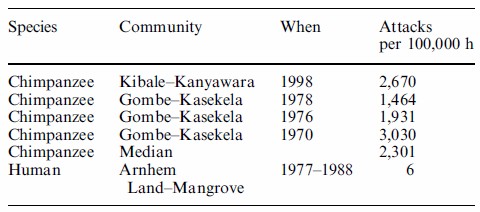
In the course of conducting some morning research on chimpanzee cannibalism, we found ourselves absorbed in a 2006 paper that compared the aggressive tendencies of chimps and humans. (A PDF can be downloaded by clicking here.) As it turns out, humans and chimps are equally adept that cold-blooded murder, but our primate brethren are far bigger fans of non-lethal violence:
First, we assembled data on lethal aggression from long-term studies of nine communities of chimpanzees living in five populations. We calculated rates of death from intraspecific aggression both within and between communities. Variation among communities in mortality rates from aggression was high, and rates of death from intercommunity and intracommunity aggression were not correlated. Estimates for average rates of lethal violence for chimpanzees proved to be similar to average rates for subsistence societies of hunter–gatherers and farmers. Second, we compared rates of non-lethal physical aggression for two populations of chimpanzees and one population of recently settled hunter–gatherers. Chimpanzees had rates of aggression between two and three orders of magnitude higher than humans.
That last claim, in particular, is a gross oversimplification. For starters, as the researchers admit, their mere presence as observers of chimpanzee communities may have reduced the normal amount of violence. On top of that, as the chart above demonstrates, the gap between chimp and human aggression was particularly glaring in some instances. The Arnhem Land people, an Australian aboriginal group, experienced a rate of non-lethal aggression that was 384 times less than the chimp median. If anything, the overall human rate seems to have been knocked askew by some potentially dodgy guesswork regarding violence rates among tribes such as the Kato of 1840s California.
Our takeaway here is that chimps engage in more non-lethal violence simply because they’re yet to develop socially acceptable—and less destructive—outlets for the innate aggressive tendencies they share with our species. Perhaps mankind’s genius wasn’t necessarily the invention of agriculture, then, but rather violent diversions that, while certainly dangerous to the actors directly involved, actually served to reduce population-wide attacks.
Hey, we’re sure it was no fun to be a gladiator, especially a retiarii doomed to fail. But better those few unlucky “athletes” be sacrificed than have every Roman clubbing his neighbor over the head. And once we figured out that non-lethal spectacles could suffice, our species was really rolling.
Much more on chimp aggression here, via Jane Goodall’s marvelous (and chilling) recounting of the Gombe “Four Year War.”


Like gas stations in rural Texas after 10 pm, comments are closed.